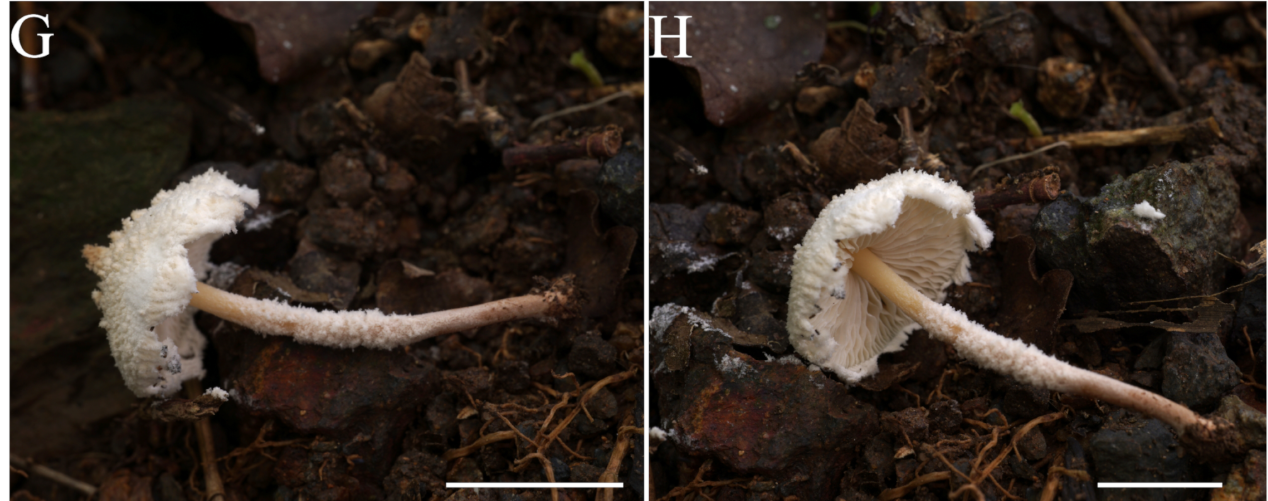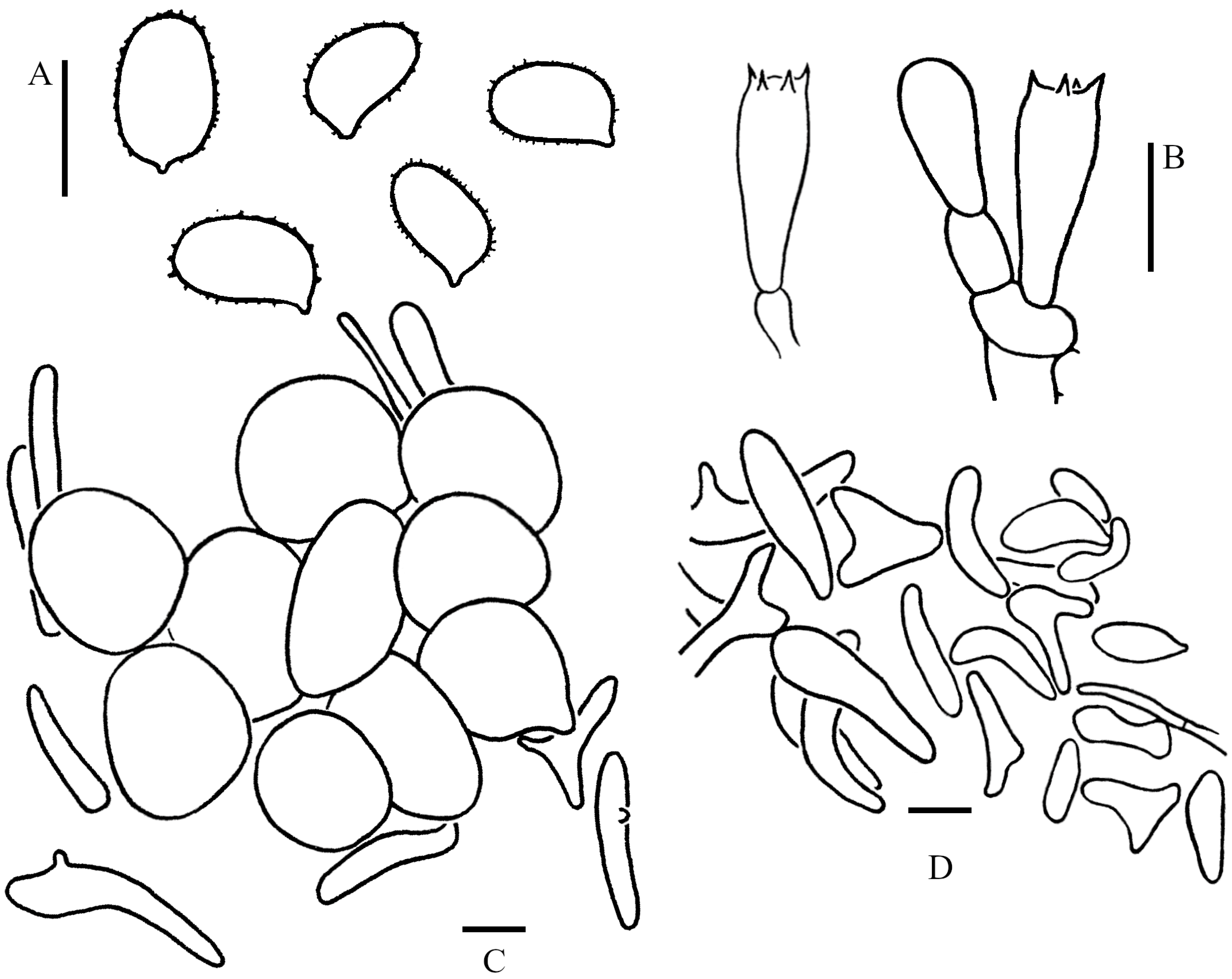欧氏粉鳞环柄菇Pulverolepiota oliveirae
(P. Roux, M. Paraíso, J. P. Maurice, A. C. Normand & F. Fouchier) H. Qu, Damm & Z. W. Ge 2023
基本信息 | - 通用中文名Chinese name:欧氏粉鳞环柄菇
- 拉丁学名Scientific name:Pulverolepiota oliveirae (P. Roux, M. Paraíso, J. P. Maurice, A. C. Normand & F. Fouchier) H. Qu, Damm & Z. W. Ge 2023
- 科family:疣孢环柄菇科Verrucosporaceae
- 属Genus:粉鳞环柄菇属Pulverolepiota
- 分布Distribution:澳大利亚、欧洲(葡萄牙)、中国
- 有分布的省区Provinces:云南省(文献记载)
查看具体分布情况 - 生态Ecology:单生或散生于土壤上。在澳大利亚,有生长在蚌壳蕨上的记录
- 营养类型Nutrition Type:腐生Saprotrophic: 分解死亡生物体或有机物获取养分
- 置信指标Confidence:★★★
|
介绍部分
简介:欧氏粉鳞环柄菇最初被描述于葡萄牙,当时被置于囊小伞属中,后来Qu et al. 2023将其转移到粉鳞环柄菇属中。该物种的特征是菌盖白色至奶油色,表面覆盖有直立丛毛状鳞片,来自中国的标本在菌盖中部有凸起,菌柄褐色覆有丛毛状鳞片,无囊状体,孢子粗糙,在梅氏试剂中缓慢变红褐色,菌盖表皮由少量密集排列的球形细胞和疏松的分支形、不规则形或圆柱形细胞组成。
相似物种
囊小伞属的一些物种相似,但它们的担孢子在梅氏试剂中不变红褐色,担孢子光滑,存在锁状联合,拥有囊状体,菌盖表皮中不存在疏松的分支形、不规则形或圆柱形细胞。
粉鳞环柄菇和本物种相似,但本物种菌盖表皮有少量密集排列的球形细胞,分布于疏松的细胞中,而粉鳞环柄菇不存在这种特征。
物种介绍引证的参考文献
(上文介绍部分中所引用的参考文献)
- Taxonomy and Phylogeny of Cystolepiota (Agaricaceae, Agaricales): New Species, New Combinations and Notes on the C. seminuda Complex, 2023. Hua Qu, Ulrike Damm, Ya-Jun Hou, Zai-Wei Ge. J. Fungi 9(5) https://doi.org/10.3390/jof9050537
涉及到该物种的相关文献
(能证明该种在我国有分布的文献)
- Taxonomy and Phylogeny of Cystolepiota (Agaricaceae, Agaricales): New Species, New Combinations and Notes on the C. seminuda Complex, 2023. Hua Qu, Ulrike Damm, Ya-Jun Hou, Zai-Wei Ge. J. Fungi 9(5) https://doi.org/10.3390/jof9050537
物种描述
以下描述摘自相关参考文献,仅供参考。可能存在文献过时、描述错误或者描述片面等情况
文字识别时可能有纰漏,描述若与参考文献原文有出入以原文为准
外文描述的参考翻译系网站管理者的个人翻译,仅供参考,具体以原文为准
描述1 描述来源:Taxonomy and Phylogeny of Cystolepiota (Agaricaceae, Agaricales): New Species, New Combinations and Notes on the C. seminuda Complex类型:完整的描述(摘录自专著、论文等)
描述原文:
Pulverolepiota oliveirae (P. Roux, M. Paraíso, J. P. Maurice, A. C. Normand & F. Fouchier) H. Qu, Damm & Z. W. Ge, comb. nov. Figure 3G,H, Figure 4J,K and Figure 9.
≡ Cystolepiota oliveirae P. Roux, M. Paraíso, J. P. Maurice, A. C. Normand & F. Fouchier, Mycologia Montenegrina 19: 22 2017 (Basionym).
MycoBank: MB847958
Description: Pileus 14 mm in diam, about 18 mm high, plano-conical, with a distinct umbo, surface whitish to cream, covered with thick flocculose squamules, erect at center, brownish orange (6C8) at the center, fading to yellowish or pale orange (5A2-4) or cream toward the margin; margin appendiculate, easily detachable. Lamellae free, wavy, brownish (5B2), distant, up to 2 mm broad, with 2–3 tiers of lamellulae. Stipe 30 × 1.5 mm, light orange (5A5) at the upper part, reddish-orange (7A6-8) at the base, central, hollow, subcylindrical, with a slightly bulbous base; surface smooth, covered with white, flocculose, easily-detachable squamules on the middle part. Context white in stipe and pileus, thin. Odorless; taste not recorded.
Basidiospores [30/1/1] (4–)4.5–5.5(–6) × (2.5–)3–3.5 μm, Q = (1.43–)1.46–1.86(–2.03), Qm = 1.66 ± 0.14, ellipsoid, colorless, thin-walled, nonamyloid, slowly staining to reddish-brown in Melzer’s reagent (after 24 h); metachromatic in cresyl blue; surface distinctly punctate-rough under LM; isolated irregular warts (up to 0.3 µm in height) visible under SEM (Figure 4J,K); apiculus small. Basidia 14.5–18.5 × 5–7 μm, clavate, hyaline, 4-spored; sterigmata 1.5–3 μm long. Lamellar trama regular, made up of colorless cylindrical hyphae, 3–10 μm in diam. Cheilocystidia and pleurocystidia not observed. Squamules mainly composed of loosely arranged, irregular, branched, cylindrical, oblong cells with a brownish, slightly thick wall; rare tightly-arranged globose to subglobose cells present in the midst of loosely arranged cells, 36–55 × 40–70 μm, colorless, covered with thick gelatinous substances. Clamp connections absent (Figure 9).
Specimen examined: China, Yunnan Province, Xishuangbanna Dai Autonomous Prefecture, Jinghong City, Xishuangbanna Primitive Forest Park, on the roadside, 100.8837777° N, 22.0348152° E, alt. 718 m, 5 July 2021, H. Qu 375 (KUN-HKAS 124759).
Habitat and distribution: Solitary or scattered on soil or on a trunk of Dicksonia antarctica in Europe (Portugal), Asia (tropical region of southwestern China) and Australia.
Notes:Pulverolepiota oliveirae was described as C. oliveirae from Portugal [55], characterized by a whitish to cream pileus with erect flocculose squamules, a brown stipe with white flocculose squamules, a lack of cystidia, and rough and slow-staining dextrinoid spores. Our collection represents a new report for China; it matched the protologue of P. oliveirae regarding macro- and micro-characteristics, except for the pileus of the specimen from China that has a distinct umbo. The basidiospores of the specimen from China [(4–)4.5–5.5(–6) × (2.5–)3–3.5 µm] are slightly smaller than those in the protologue of C. oliveirae (5.0–6.4 × 2.9–4.0 µm) [55]. The morphological differences could be explained by population and measurement differences. Furthermore, the ITS sequence is 99.74% identical with the sequence generated from the type specimen (KY472789).
The two closely related species, P. oliveirae and P. petasiformis (=C. pulverulenta) can easily be confused. However, the squamules of C. oliveirae present tightly-arranged globose to subglobose cells among the loosely-arranged cells. Those tightly arranged cells have not been observed in C. petasiformis [5,56]. Paraíso et al. (2016) suggested the size of the basidiospores as a characteristic to distinguish the two species [55]. However, the spores of the collection from China are not significantly larger than those of C. petasiformis. Several Cystolepiota species, including C. fumosifolia, C. pseudofumosifolia, and C. pyramidalis, that are not closely related with P. oliveirae are also similar in the presence of distinct squamules. However, they differ in forming cheilocystidia, inamyloid and non-dextrinoid basidiospores and squamules that are composed of loosely-arranged globose to subglobose cells, while irregular, branched, cylindrical to oblong cells are lacking. Cystolepiota pyramidosquamulosa, a species newly described in this paper, also forms distinct squamules. It can be distinguished from P. oliveirae by having neither amyloid nor dextrinoid basidiospores and forming loosely-arranged globose to subglobose cells in the squamules.
库中图片 2 张
标签:[无]
上次编辑:2025-10-15
物种编号:1017
Revised:true
本页向外链接的参考文献:总计 5 条链接(含重复)
重定向至本页的页面:总计 0 条链接
©菌物志Mycopedia
回到首页 搜索物种 目录
©菌物志Mycopedia,版权声明
如需引用本文可参考下列格式:
蔡佳铭.2025. 欧氏粉鳞环柄菇Pulverolepiota oliveirae. 菌物志Mycopedia. http://www.mycopedia.top/result.php?details=Pulverolepiota oliveirae
Jia-Ming Cai.2025. Pulverolepiota oliveirae [Chinese]. Mycopedia. http://www.mycopedia.top/result.php?details=Pulverolepiota oliveirae


